A Novel Partial Discharge Ultra-High Frequency Signal De-Noising Method Based on a Single-Channel Blind Source Separation Algorithm
Abstract
1. Introduction
2. Single-Channel Blind Source Separation De-Noising Algorithm
2.1. BSS Mathematical Model
2.2. Number Estimation of Source Signals
2.3. Multi-Channel Detected Signal Recombination
2.4. BSS De-Noising Method Based on the JADE Algorithm
2.5. PD Signal Recovery After De-Noising
3. Simulation Test of De-Noising
3.1. Simulation Test Signals
3.2. De-Noising Results and Discussion
4. Field Test for De-Noising
5. Conclusions
- (1)
- The submatrix of the SVD decomposition of the original PD signal can convert the single-channel detected PD signal into multi-channel PD signals; the underdetermined problem of blind source separation can be effectively solved.
- (2)
- The l1-norm minimization method can effectively solve the large amplitude vibration problem after single-channel blind source separation, which is better for the subsequent signal processing and analysis.
- (3)
- Compared with traditional methods, the proposed method can effectively de-noise the Gaussian white noise and periodic narrow-band interference, and have small distortion.
Acknowledgments
Author Contributions
Conflicts of Interest
References
- Mor, A.R.; Heredia, L.C.; Munoz, F.A. Estimation of charge, energy and polarity of noisy partial discharge pulses. IEEE Trans. Dielectr. Electr. Insul. 2017, 24, 2511–2521. [Google Scholar] [CrossRef]
- Wang, X.; Li, X.; Rong, M.; Xie, D.; Ding, D.; Wang, Z. UHF Signal Processing and Pattern Recognition of Partial Discharge in Gas-Insulated Switchgear Using Chromatic Methodology. Sensors 2017, 17, 177. [Google Scholar] [CrossRef] [PubMed]
- Illias, H.A.; Tunio, M.A.; Bakar, A.H.A.; Mokhlis, H.; Chen, G. Partial discharge phenomena within an artificial void in cable insulation geometry: Experimental validation and simulation. IEEE Trans. Dielectr. Electr. Insul. 2016, 23, 451–459. [Google Scholar] [CrossRef]
- Zhang, X.; Cheng, Z.; Gui, Y. Design of a New Built-in UHF Multi-Frequency Antenna Sensor for Partial Discharge Detection in High-Voltage Switchgears. Sensors 2016, 16, 1170. [Google Scholar] [CrossRef] [PubMed]
- Sriram, S.; Nitin, S.; Prabhu, K.M.M.; Bastiaans, M.J. Signal denoising techniques for partial discharge measurements. IEEE Trans. Dielectr. Electr. Insul. 2005, 12, 1182–1191. [Google Scholar] [CrossRef]
- Khan, S.Z.; Deheng, Z.; Xianhe, J.; Kexiong, T. A new adaptive technique for on-line partial discharge monitoring. IEEE Trans. Dielectr. Electr. Insul. 1995, 2, 700–707. [Google Scholar] [CrossRef]
- Shang, H.; Lo, K.L.; Li, F. Partial Discharge Feature Extraction Based on Ensemble Empirical Mode Decomposition and Sample Entropy. Entropy 2017, 19, 439. [Google Scholar] [CrossRef]
- Shetty, P.K.; Ramu, T.S. An Undecimated Wavelet Transform Based Denoising, PPCA Based Pulse Modeling and Detection-Classification of PD Signals. In Proceedings of the 17th International Conference on Pattern Recognition, Cambridge, UK, 26 August 2004. [Google Scholar]
- Ma, X.; Zhou, C.; Kemp, I.J. Interpretation of wavelet analysis and its application in partial discharge detection. IEEE Trans. Dielectr. Electr. Insul. 2002, 9, 446–457. [Google Scholar] [CrossRef]
- Lu, J.; Zhang, X.; Xiong, H. A New Method for Suppressing Periodic Narrowband Interference Based on the Chaotic van der Pol Oscillator. Int. J. Bifurc. Chaos 2015, 25, 1550120. [Google Scholar] [CrossRef]
- Yuhui, Z.; Weirun, D.; Tianyun, L. A reverse separation method of suppressing periodic narrowband noise in partial discharge signal. Trans. China Electr. Soc. 2015, 30, 232–239. (In Chinese) [Google Scholar]
- Majidi, M.; Fadali, M.S.; Etezadi-Amoli, M.; Oskuoee, M. Partial discharge pattern recognition via sparse representation and ANN. IEEE Trans. Dielectr. Electr. Insul. 2015, 22, 1061–1070. [Google Scholar] [CrossRef]
- Liu, Y.; Zhou, W.; Li, P.; Yang, S.; Tian, Y. An Ultrahigh Frequency Partial Discharge Signal De-Noising Method Based on a Generalized S-Transform and Module Time-Frequency Matrix. Sensors 2016, 16, 941. [Google Scholar] [CrossRef] [PubMed]
- Ashtiani, M.B.; Shahrtash, S. Feature-oriented de-noising of partial discharge signals employing mathematical morphology filters. IEEE Trans. Dielectr. Electr. Insul. 2012, 19, 2128. [Google Scholar] [CrossRef]
- Ashtiani, M.; Shahrtash, S. Partial discharge de-noising employing adaptive singular value decomposition. IEEE Trans. Dielectr. Electr. Insul. 2014, 21, 775–782. [Google Scholar] [CrossRef]
- Bell, A.J.; Sejnowski, T.J. An information-maximization approach to blind separation and blind deconvolution. Neural Comput. 1995, 7, 1129–1159. [Google Scholar] [CrossRef] [PubMed]
- Amari, S.-I.; Cardoso, J.-F. Blind source separation—Semiparametric statistical approach. IEEE Trans. Signal Process. 1997, 45, 2692–2700. [Google Scholar] [CrossRef]
- Amari, S.I.; Chen, T.P.; Cichoki, A. Stability analysis of adaptive blind source separation. Neural Netw. 1997, 10, 1345. [Google Scholar] [CrossRef]
- Belouchrani, A.; Abed-Meraim, K.; Cardoso, J.F.; Moulines, E. A blind source separation technique using second-order statistics. IEEE Trans. Signal Process. 1997, 45, 434–444. [Google Scholar] [CrossRef]
- Yang, Y.; Zhang, D.; Peng, H. Single-channel blind source separation for paired carrier multiple access signals. IET Signal Process. 2017, 12, 37–41. [Google Scholar] [CrossRef]
- Wang, K.; Liao, R.; Yang, L.; Li, J.; Grzybowski, S.; Hao, J. Optimal features selected by NSGA-II for partial discharge pulses separation based on time-frequency representation and matrix decomposition. IEEE Trans. Dielectr. Electr. Insul. 2013, 20, 825–838. [Google Scholar] [CrossRef]
- Rodriguez, A.; Laio, A. Machine learning. Clustering by fast search and find of density peaks. Science 2014, 344, 1492–1496. [Google Scholar] [CrossRef] [PubMed]
- Luo, B.; Hancock, E.R. Structural graph matching using the EM algorithm and singular value decomposition. IEEE Trans. Pattern Anal. Mach. Intell. 2001, 23, 1120–1136. [Google Scholar]
- Dai, D.; Wang, X.; Long, J.; Tian, M.; Zhu, G.; Zhang, J. Feature extraction of GIS partial discharge signal based on S-transform and singular value decomposition. IET Sci. Meas. Technol. 2017, 11, 186–193. [Google Scholar] [CrossRef]
- Wu, H.C.; Huang, X.; Wu, Y.; Wang, X. Theoretical studies and efficient algorithm of semi-blind ICI equalization for OFDM. IEEE Trans. Wirel. Commun. 2008, 7, 3791. [Google Scholar] [CrossRef]
- Asif, M.S.; Romberg, J. Fast and Accurate Algorithms for Re-Weighted l1-Norm Minimization. IEEE Trans. Signal Process. 2013, 61, 5905–5916. [Google Scholar] [CrossRef]
- Kopf, U.; Feser, K. Rejection of narrow-band noise and repetitive pulses in on-site PD measurements. IEEE Trans. Dielectr. Electr. Insul. 1995, 2, 433–446. [Google Scholar] [CrossRef]
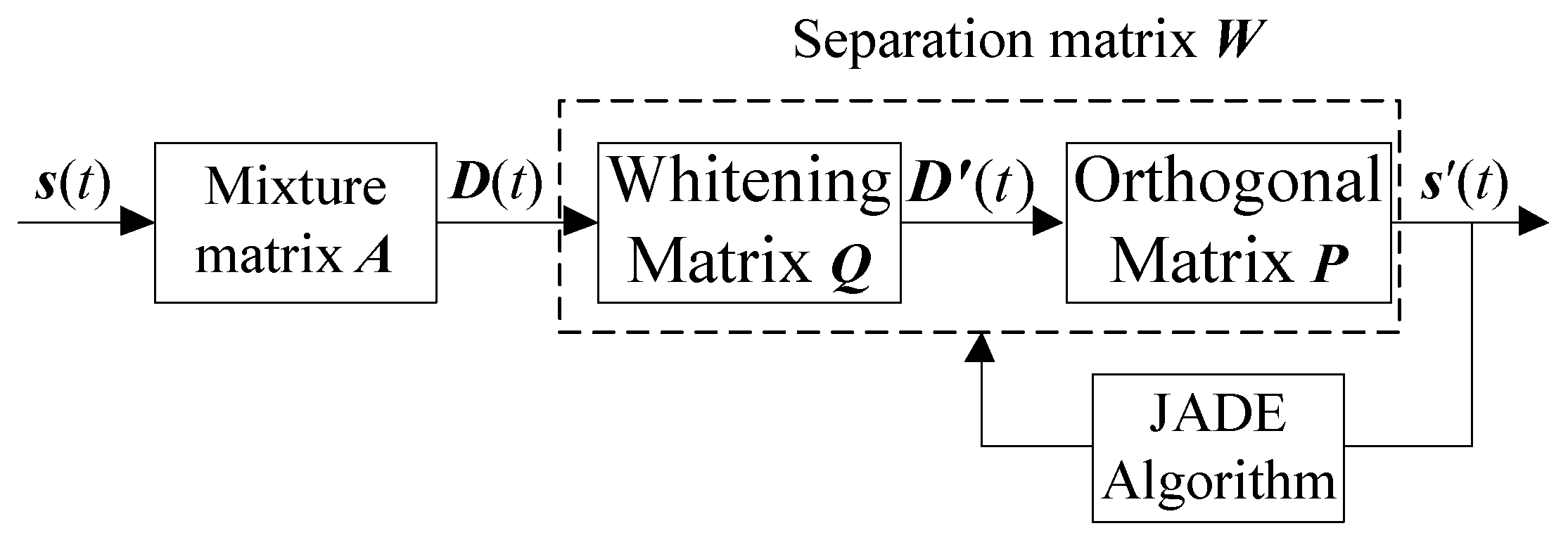
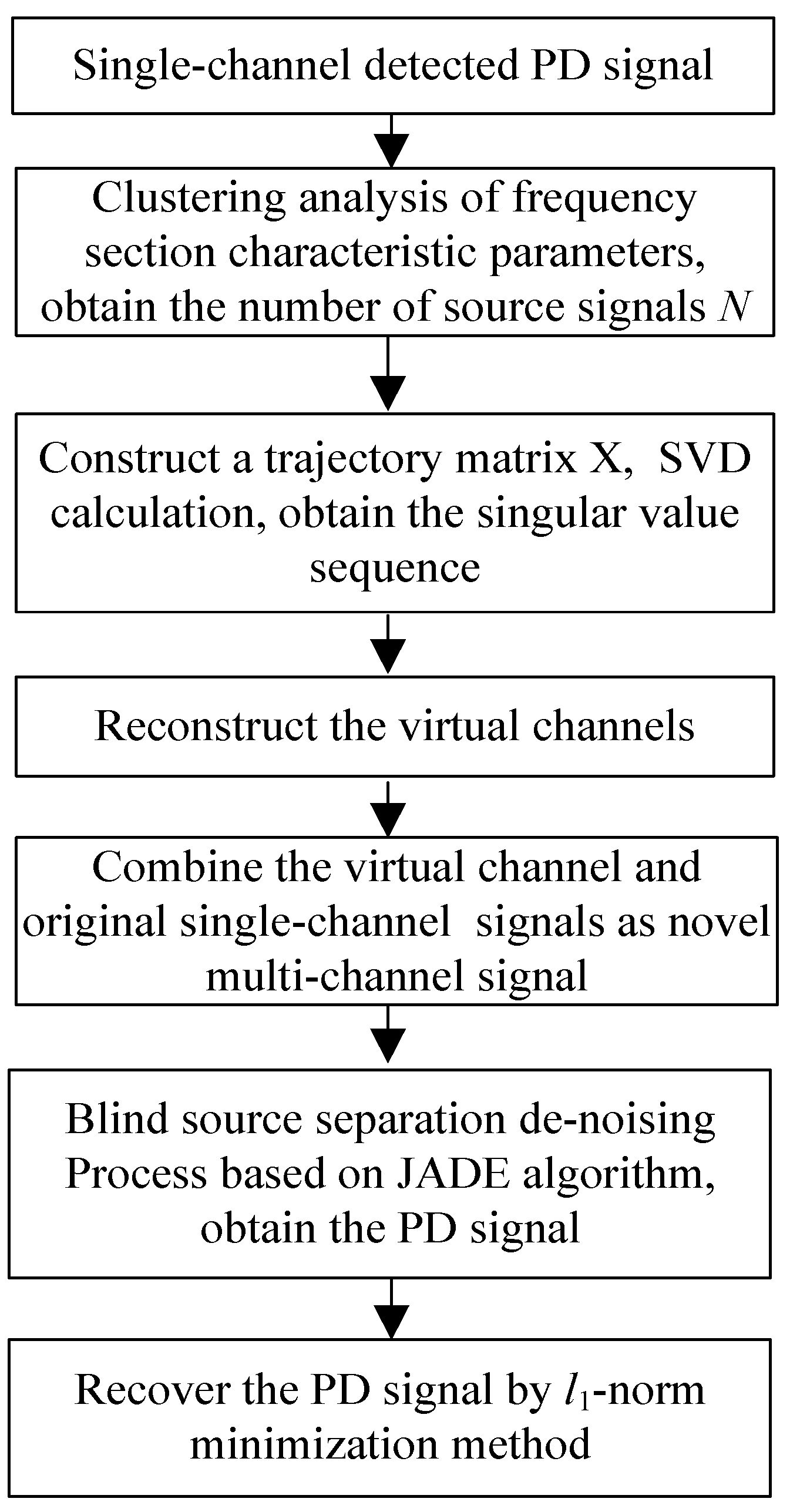
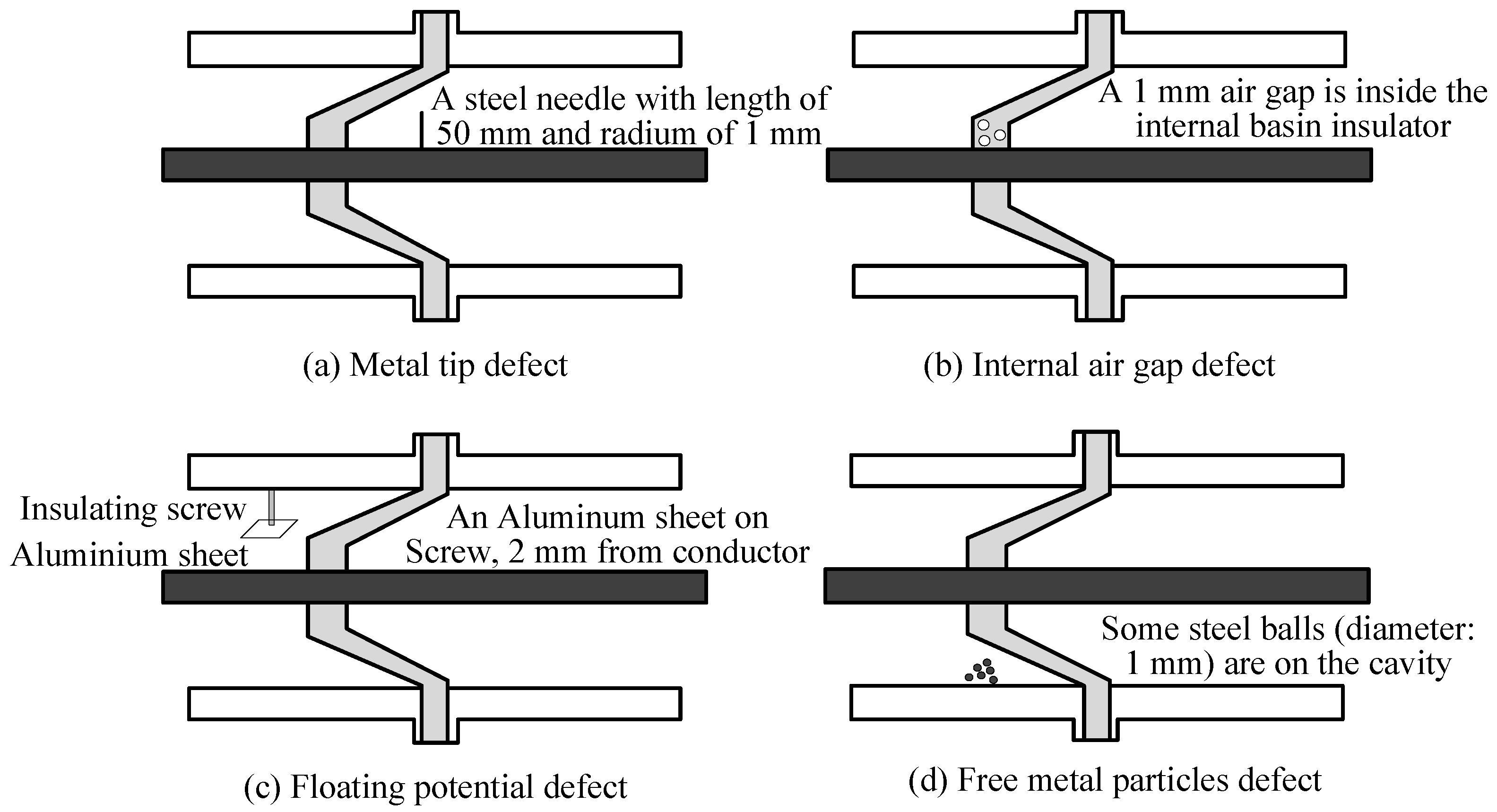
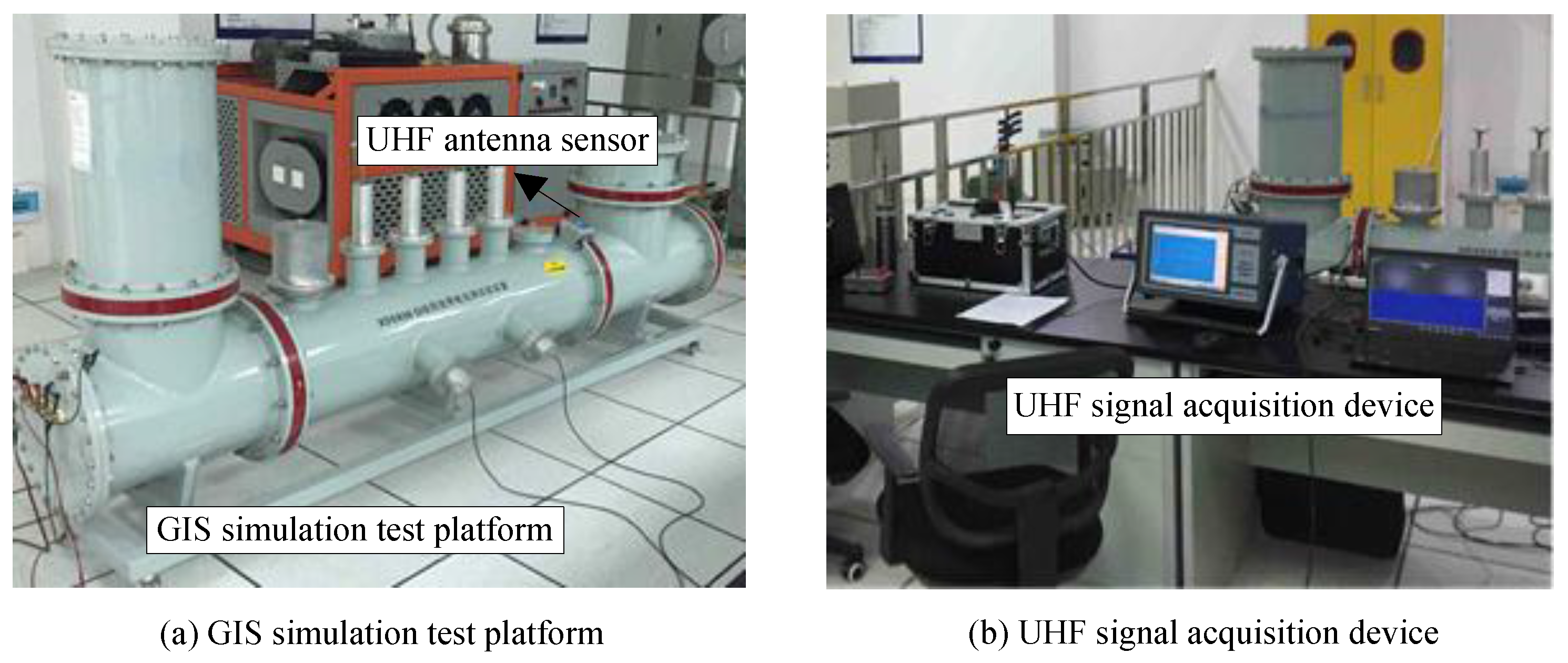
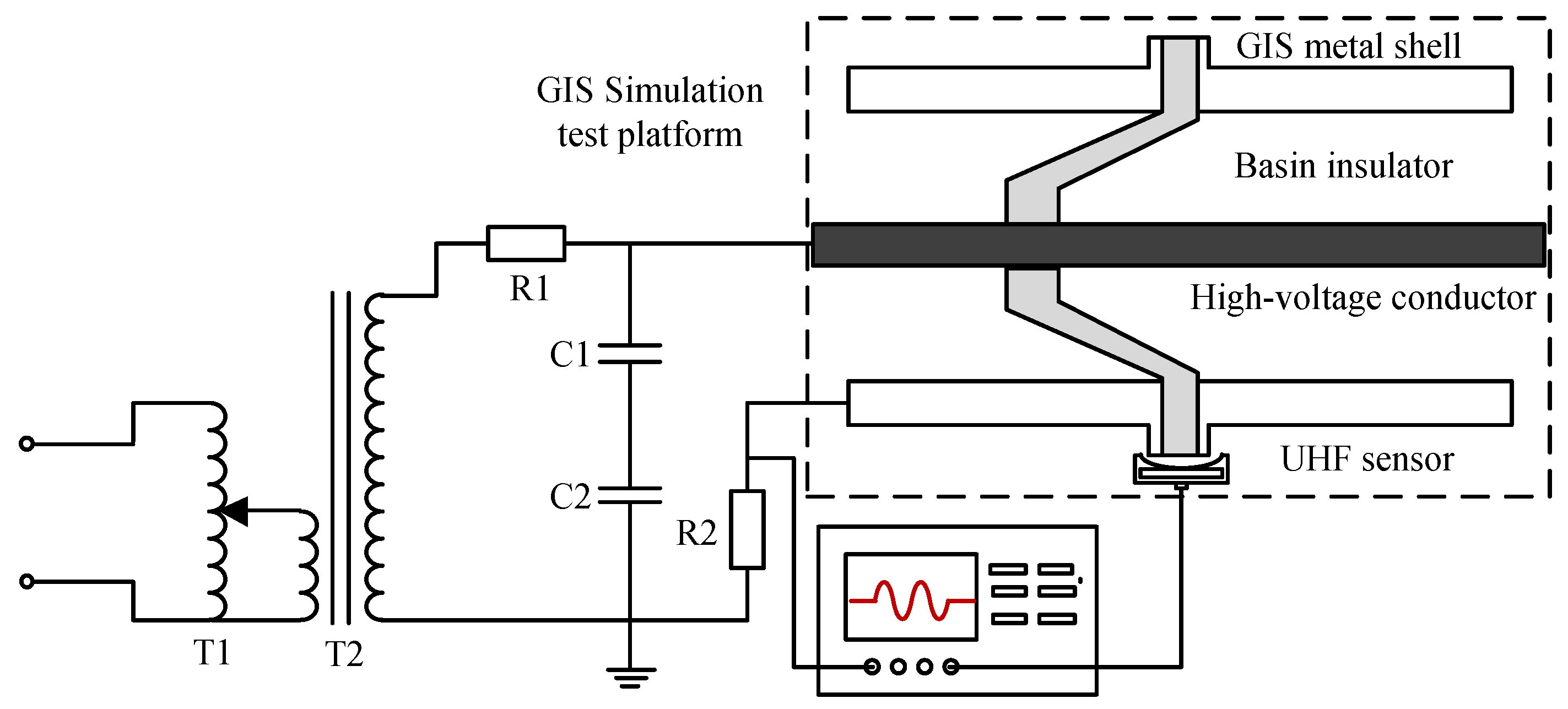
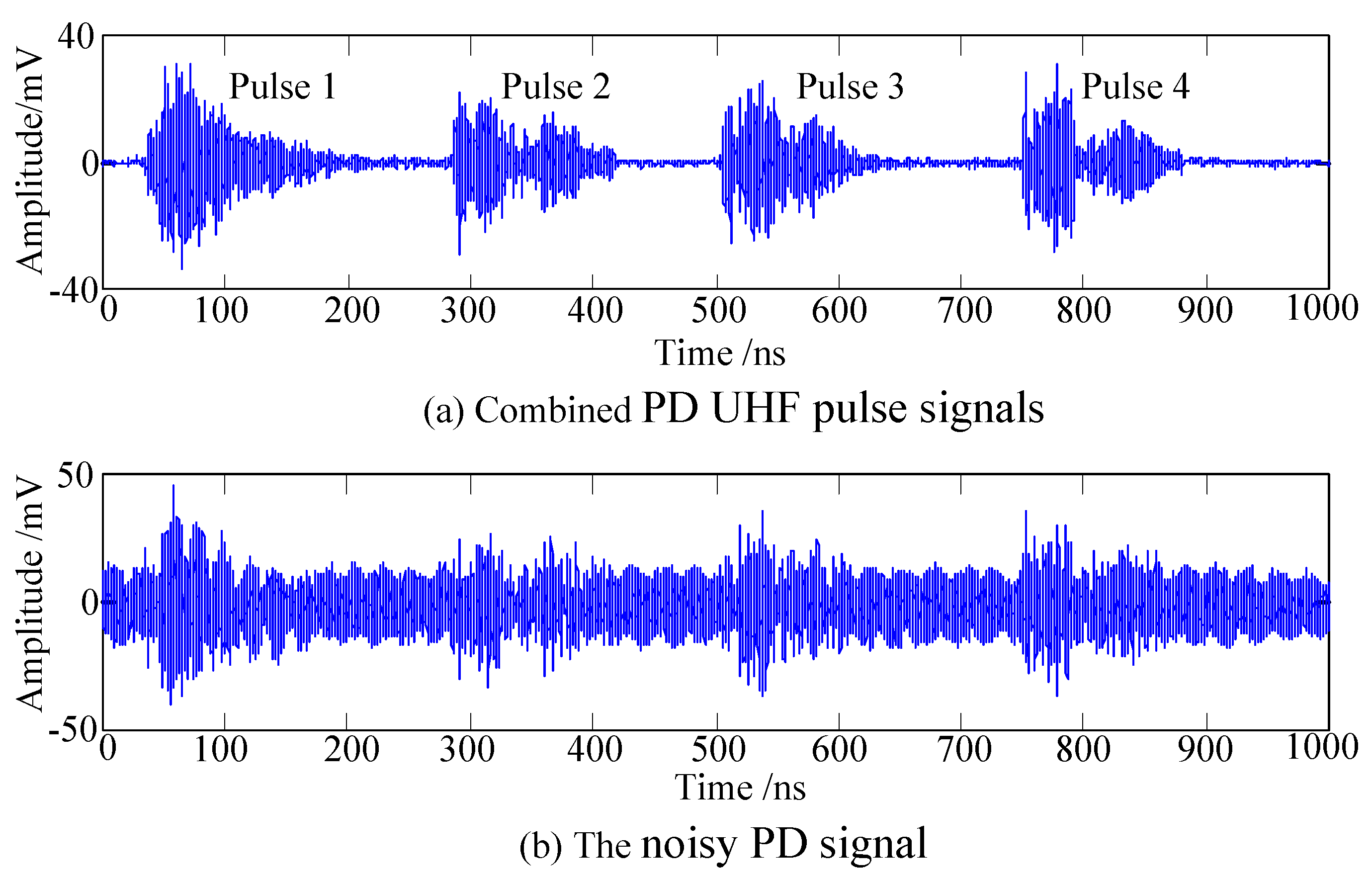
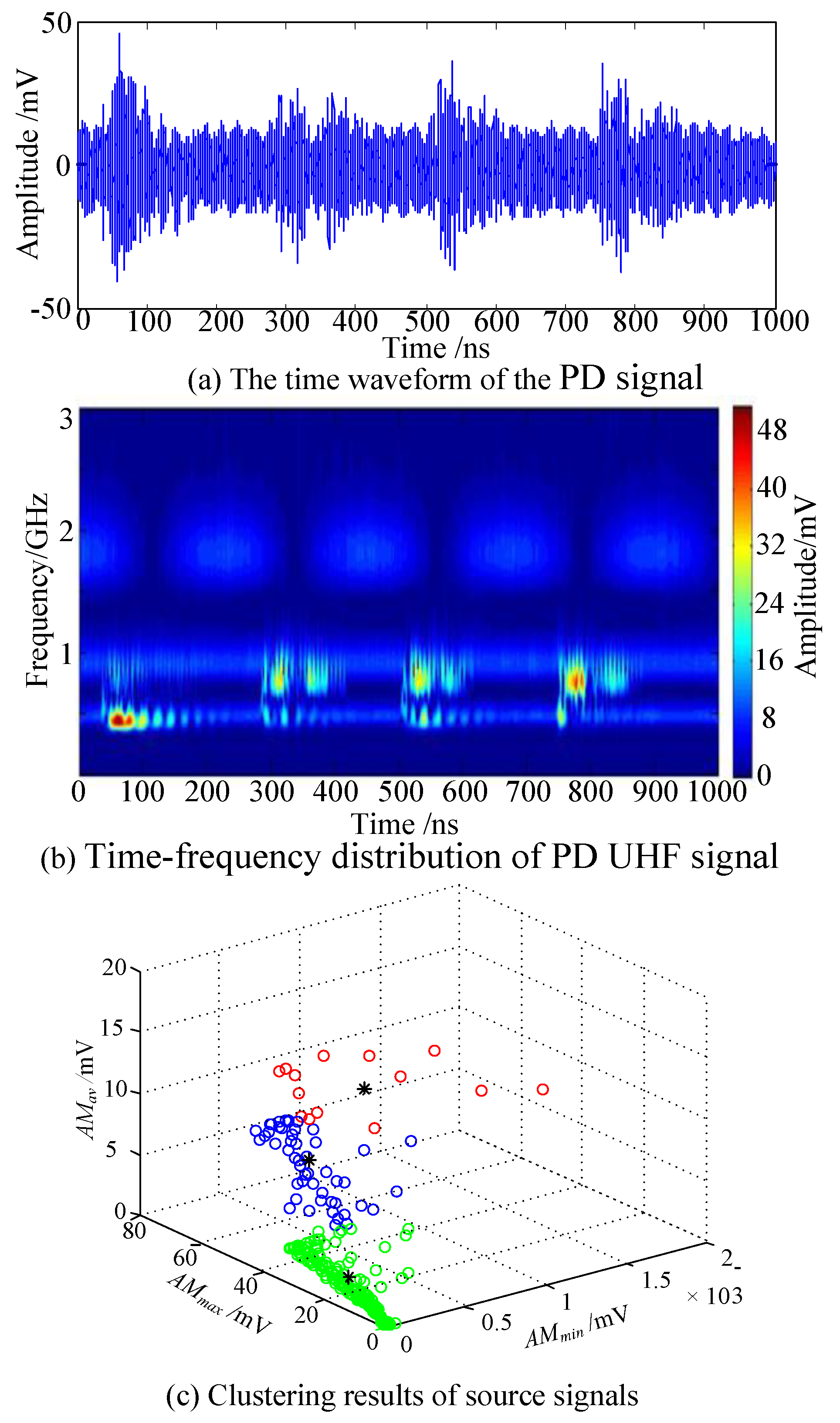

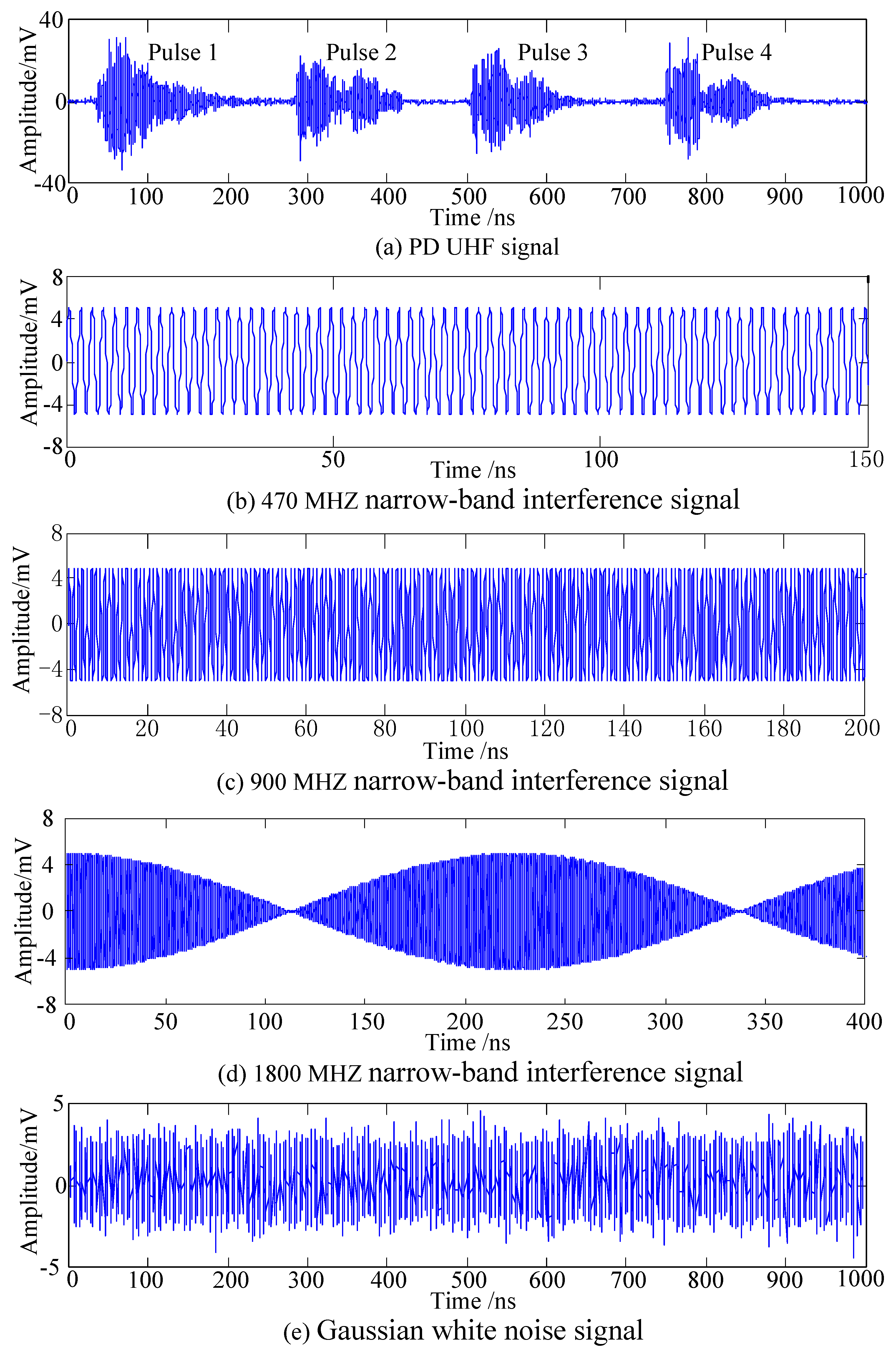
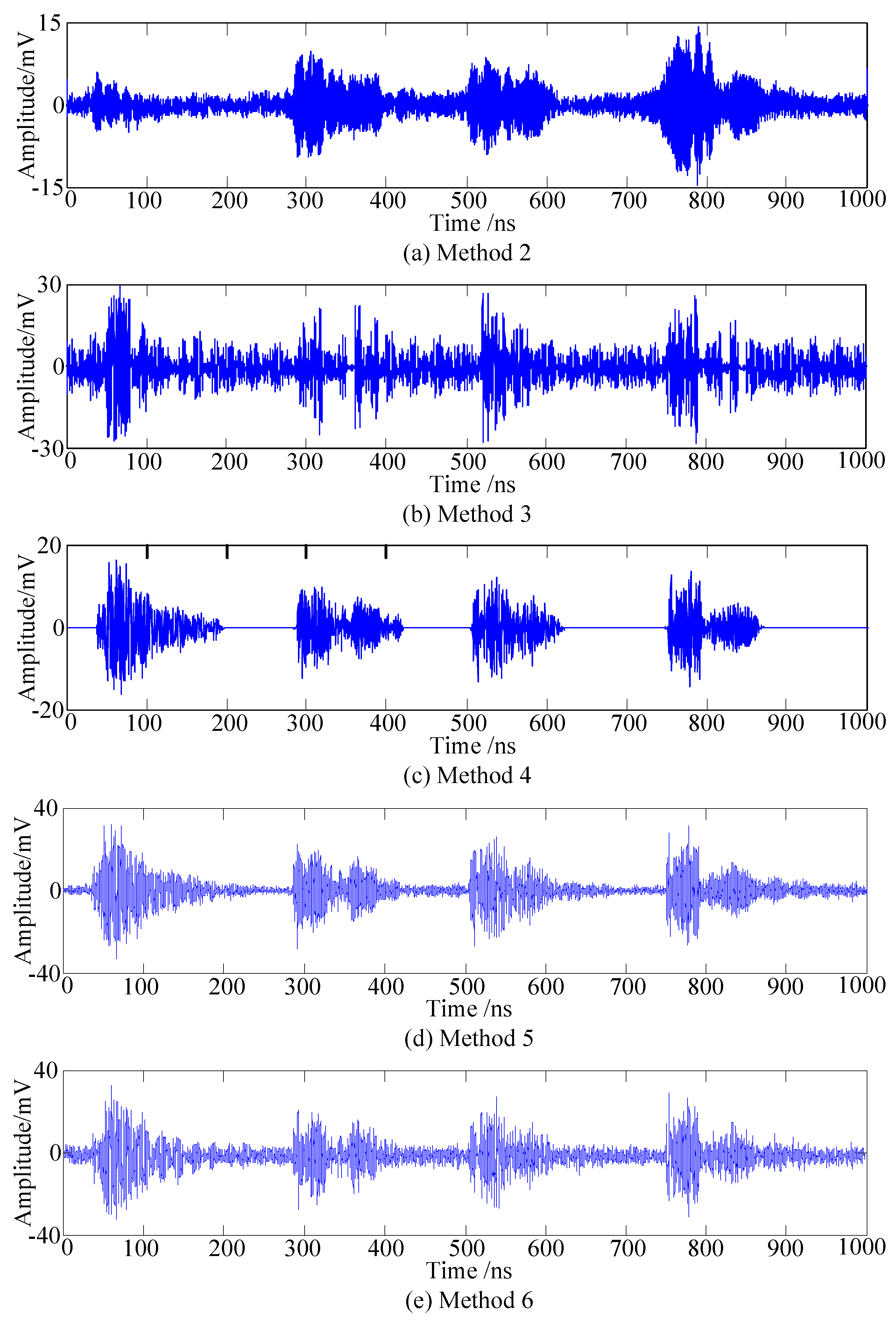
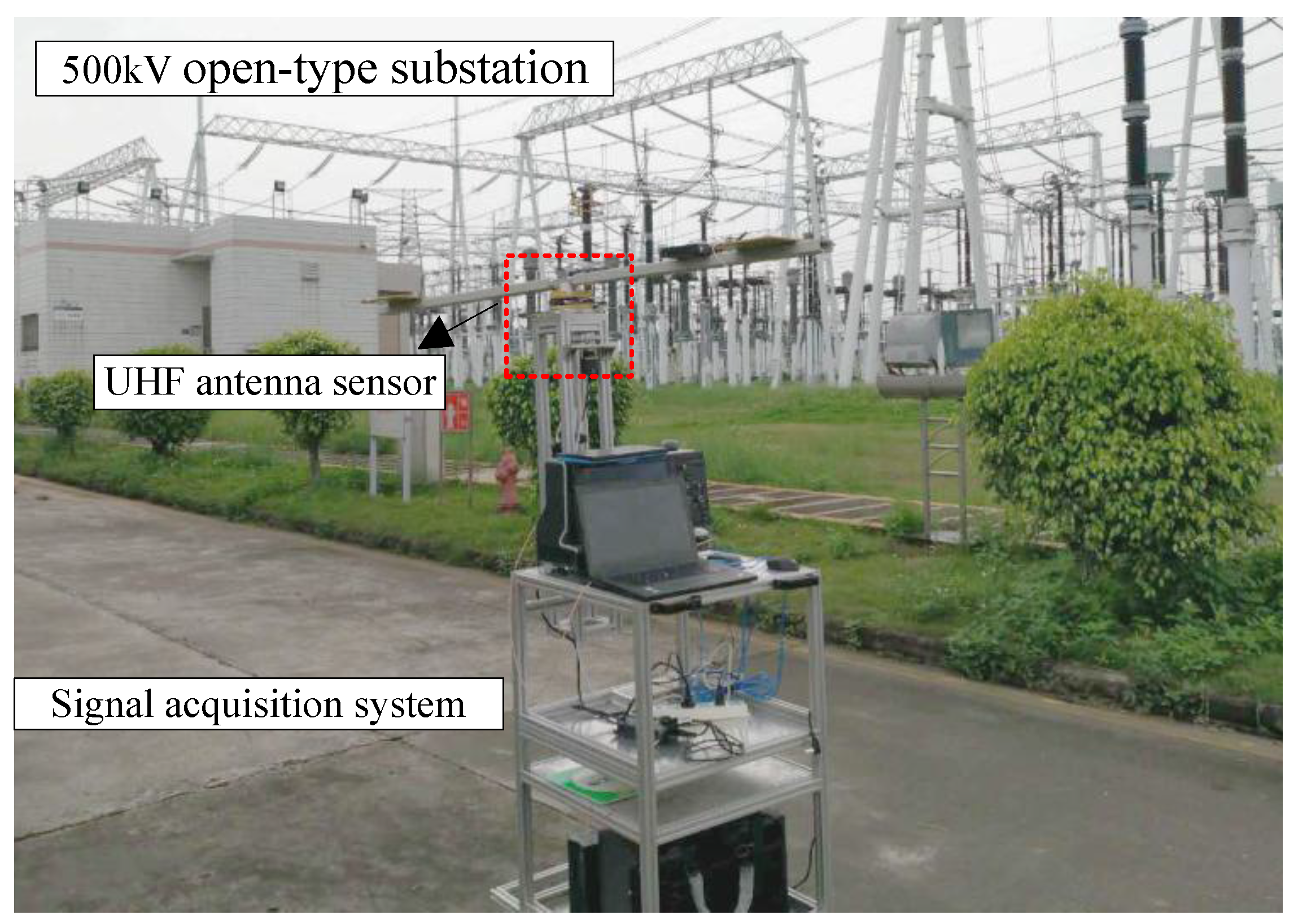

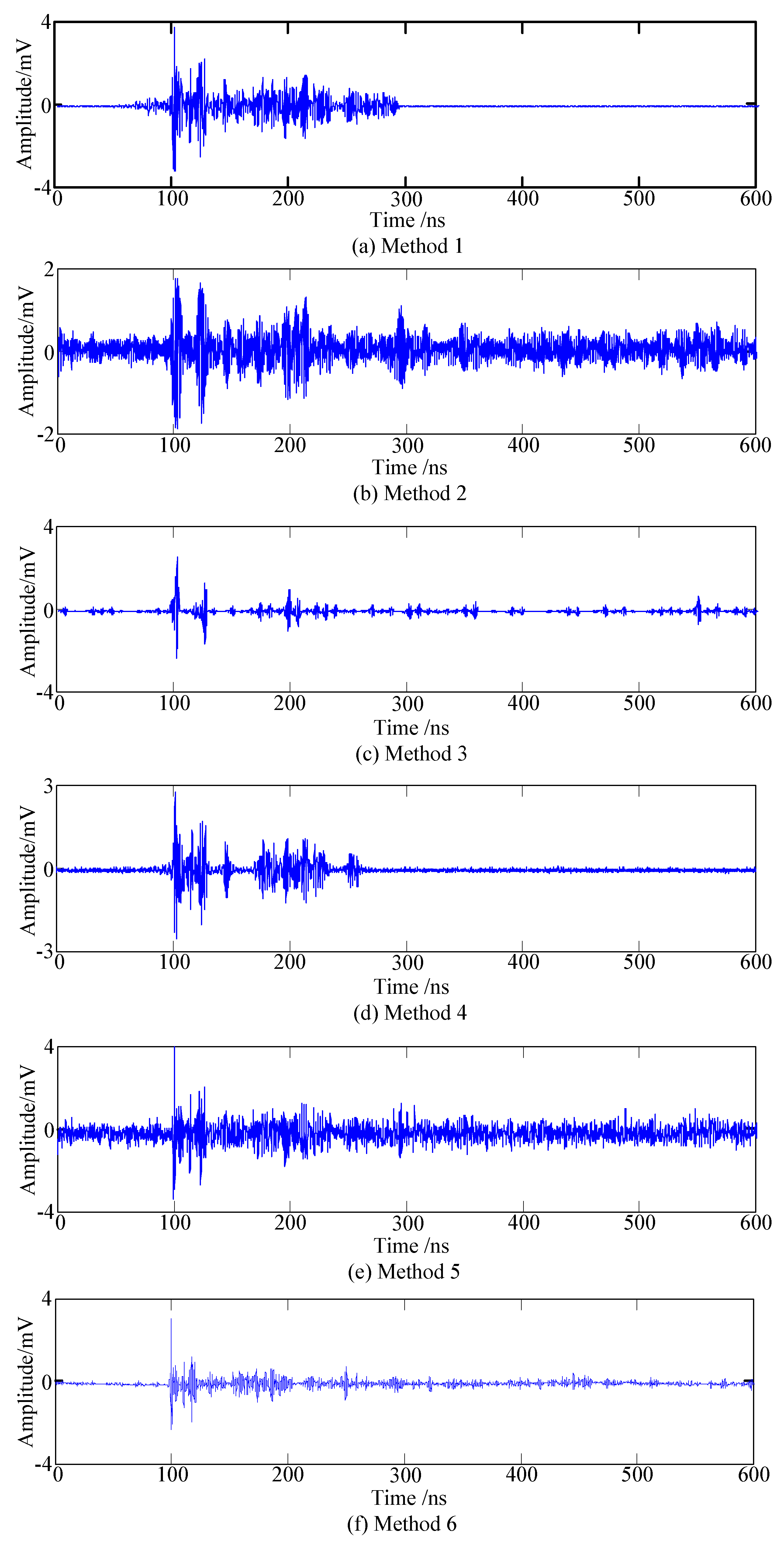
| Insulation Defect Types | Test Voltage | Pulse Sequence |
|---|---|---|
| Metal tip | 27.8 kV | Pulse 1 |
| Internal air gap | 21.6 kV | Pulse 2 |
| Floating potential | 22.4 kV | Pulse 3 |
| Free metal particles | 29.5 kV | Pulse 4 |
| Method | De-Noising Method |
|---|---|
| Method 1 | Proposed single-channel blind source separation (BSS) |
| Method 2 | Adaptive filtering de-noising (AF) |
| Method 3 | Adaptive wavelet thresholding de-noising (AWT) |
| Method 4 | Reverse separation based on independent component analysis (RS) |
| Method 5 | Generalized S-transform module time-frequency matrix method (GSMT) |
| Method 6 | Undecimated wavelet transform de-noising method (UWT) |
| Evaluation Index | De-Nosing Method | Pulse 1 | Pulse 2 | Pulse 3 | Pulse 4 | Pulse 5 |
|---|---|---|---|---|---|---|
| Signal to noise ratio | Proposed BSS | 18.421 | 19.322 | 17.643 | 17.119 | 18.064 |
| AF | 2.662 | 4.723 | 3.982 | 5.298 | 4.209 | |
| AWT | 3.816 | 3.210 | 2.978 | 3.382 | 3.283 | |
| RS | 13.982 | 13.298 | 13.132 | 13.309 | 13.325 | |
| GSMT | 11.120 | 10.872 | 10.987 | 10.876 | 10.897 | |
| UWT | 8.142 | 7.973 | 8.023 | 8.487 | 8.201 | |
| Root-mean-square error | Proposed BSS | 0.002 | 0.003 | 0.003 | 0.003 | 0.003 |
| AF | 0.063 | 0.048 | 0.023 | 0.021 | 0.036 | |
| AWT | 0.052 | 0.059 | 0.064 | 0.053 | 0.055 | |
| RS | 0.003 | 0.003 | 0.004 | 0.003 | 0.003 | |
| GSMT | 0.006 | 0.005 | 0.006 | 0.006 | 0.006 | |
| UWT | 0.018 | 0.021 | 0.019 | 0.022 | 0.020 | |
| Waveform similarity coefficient | Proposed BSS | 0.988 | 0.969 | 0.983 | 0.911 | 0.973 |
| AF | 0.343 | 0.571 | 0.445 | 0.625 | 0.530 | |
| AWT | 0.643 | 0.634 | 0.667 | 0.671 | 0.628 | |
| RS | 0.962 | 0.953 | 0.968 | 0.973 | 0.974 | |
| GSMT | 0.893 | 0.881 | 0.896 | 0.878 | 0.856 | |
| UWT | 0.711 | 0.732 | 0.740 | 0.728 | 0.724 | |
| Variation trend parameter | Proposed BSS | 1.032 | 1.048 | 1.092 | 1.021 | 1.051 |
| AF | 1.790 | 1.532 | 1.691 | 1.598 | 1.614 | |
| AWT | 0.616 | 0.547 | 0.774 | 0.694 | 0.683 | |
| RS | 1.070 | 1.086 | 1.072 | 1.086 | 1.071 | |
| GSMT | 1.158 | 1.171 | 1.168 | 1.170 | 1.15 | |
| UWT | 0.863 | 0.927 | 0.881 | 0.893 | 0.894 |
| De-Noising Method | Noise Suppression Ratio | Amplitude Attenuation Ratio/% | Computing Time/s |
|---|---|---|---|
| Proposed BSS | 16.14 | 27.6 | 1.813 |
| AF | 8.91 | 67.4 | 0.893 |
| AWT | 13.22 | 51.3 | 1.141 |
| RS | 14.62 | 52.5 | 2.121 |
| GSMT | 10.87 | 28.3 | 6.212 |
| UWT | 12.01 | 37.6 | 1.485 |
© 2018 by the authors. Licensee MDPI, Basel, Switzerland. This article is an open access article distributed under the terms and conditions of the Creative Commons Attribution (CC BY) license (http://creativecommons.org/licenses/by/4.0/).
Share and Cite
Wei, L.; Liu, Y.; Cheng, D.; Li, P.; Shi, Z.; Huang, N.; Ai, H.; Zhu, T. A Novel Partial Discharge Ultra-High Frequency Signal De-Noising Method Based on a Single-Channel Blind Source Separation Algorithm. Energies 2018, 11, 509. https://doi.org/10.3390/en11030509
Wei L, Liu Y, Cheng D, Li P, Shi Z, Huang N, Ai H, Zhu T. A Novel Partial Discharge Ultra-High Frequency Signal De-Noising Method Based on a Single-Channel Blind Source Separation Algorithm. Energies. 2018; 11(3):509. https://doi.org/10.3390/en11030509
Chicago/Turabian StyleWei, Liangliang, Yushun Liu, Dengfeng Cheng, Pengfei Li, Zhifeng Shi, Nan Huang, Hongtao Ai, and Tianan Zhu. 2018. "A Novel Partial Discharge Ultra-High Frequency Signal De-Noising Method Based on a Single-Channel Blind Source Separation Algorithm" Energies 11, no. 3: 509. https://doi.org/10.3390/en11030509
APA StyleWei, L., Liu, Y., Cheng, D., Li, P., Shi, Z., Huang, N., Ai, H., & Zhu, T. (2018). A Novel Partial Discharge Ultra-High Frequency Signal De-Noising Method Based on a Single-Channel Blind Source Separation Algorithm. Energies, 11(3), 509. https://doi.org/10.3390/en11030509





